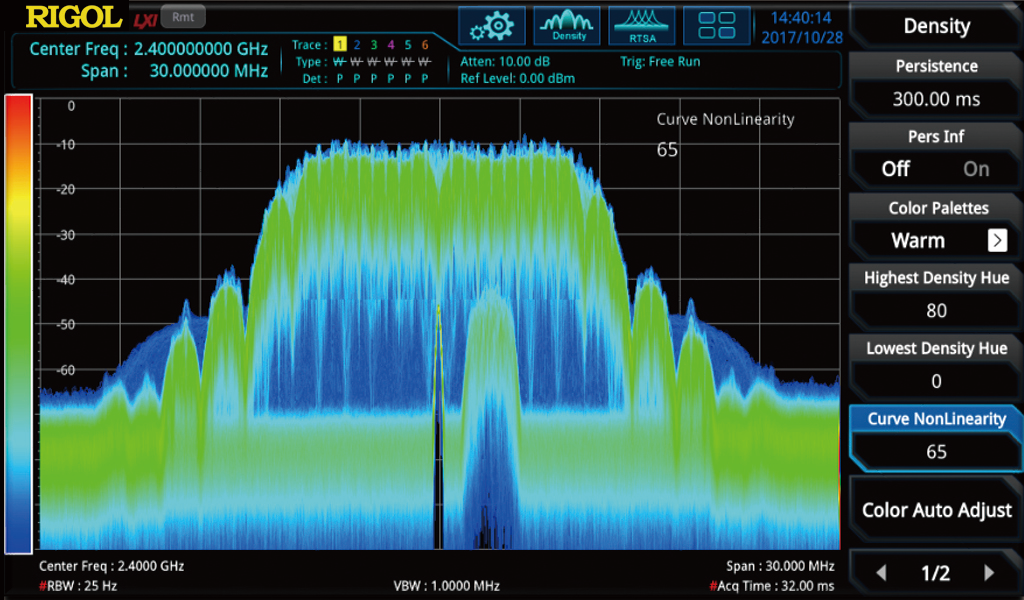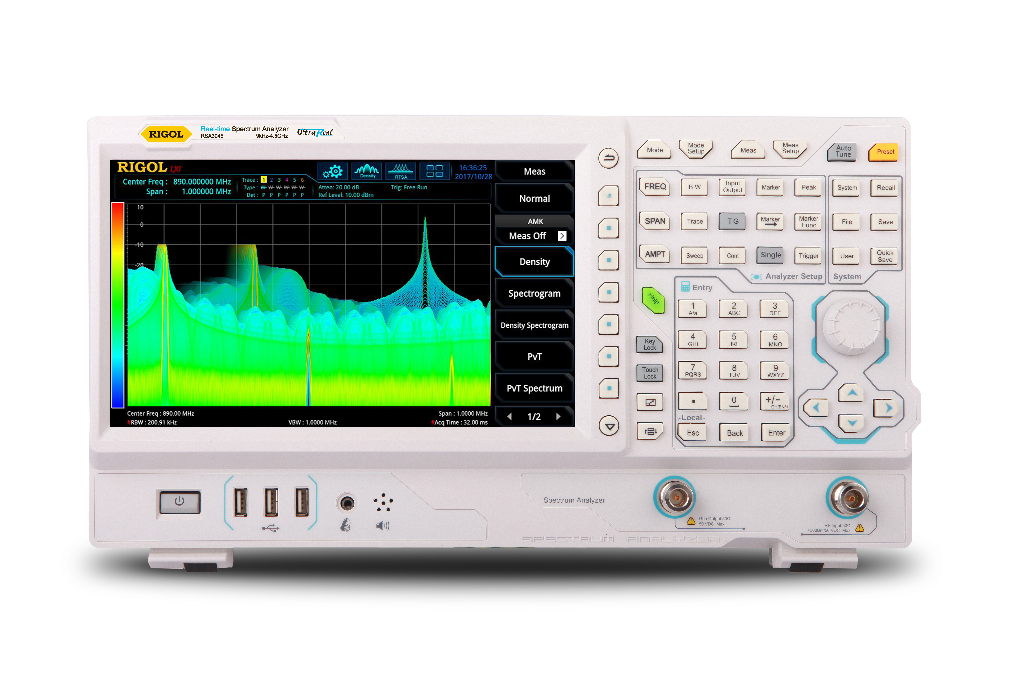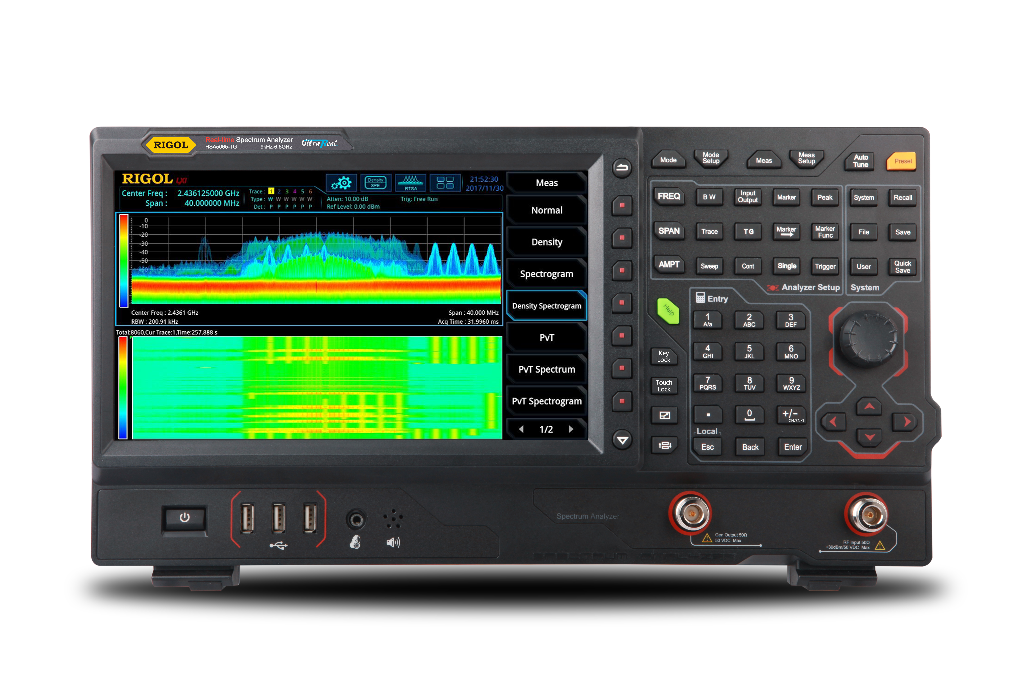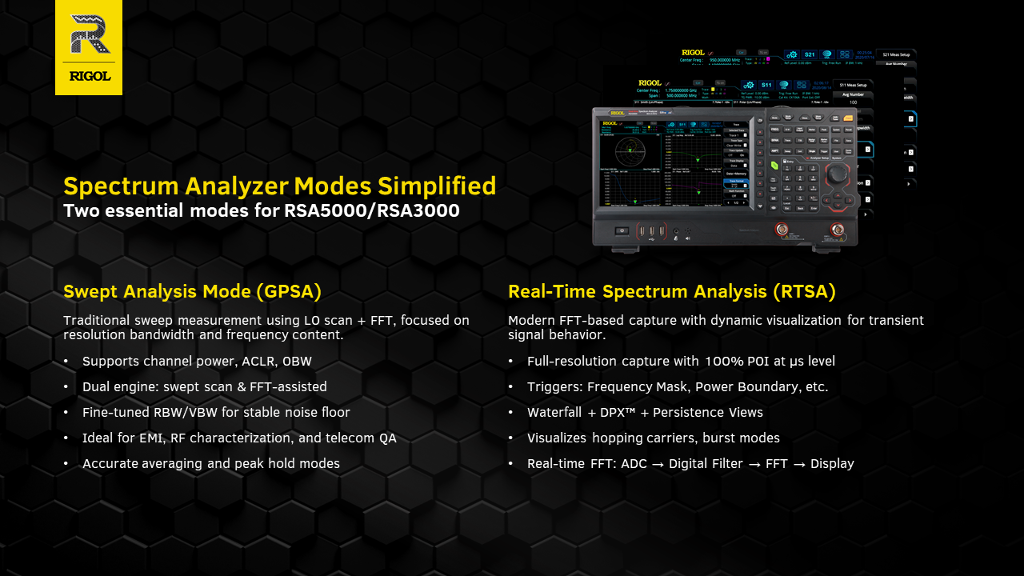
Multiple modes of spectrum analyzer
The spectrum analyzer has multiple analysis modes such as swept analysis (GPSA), real-time analysis (RTSA), vector network analysis (VNA), optional vector signal analysis (VSA), EMI measurement analysis, and analog signal demodulation function (ADM).The RSA5000/3000 series spectrum analyzers of RIGOL are standardly equipped with swept analysis (GPSA) and real-time analysis (RTSA) modes.
Swept Analysis Mode (GPSA)
The RIGOL RSA5000 series spectrum analyzer provides full-featured swept spectrum (GPSA) analysis function. Its advanced measurement mode provides test items required by transmitter test specifications such as channel power, adjacent channel leakage ratio, and occupied bandwidth.
The GPSA mode adopts two analysis methods: swept frequency and FFT. GPSA can complete both frequency domain analysis and time domain (zero sweep width) analysis. The traditional spectrum scanning technology based on superheterodyne architecture realizes frequency domain power measurement through local oscillator frequency scanning. Its core value lies in:
Broadband coverage:Support complete spectrum capture from kHz to GHz frequency bands and is suitable for wideband signal analysis.
High-precision measurement:By combining point-by-point scanning with narrowband intermediate frequency filtering, dense frequency components can be separated, and the resolution bandwidth (RBW) can reach the 1Hz level.
Dynamic range optimization:By adjusting the scan step and detector type (such as peak value and average value), it can adapt to high dynamic signals (such as the coexistence scene of communication base stations and weak noise).

Key components of sweep mode
-
Scanning generator:Control the linear or stepwise change of LO frequency and determine the scanning speed and accuracy.
-
Resolution bandwidth (RBW) :Intermediate frequency filter bandwidth directly affects the frequency resolution capability (the smaller the RBW, the higher the resolution, but the scanning time is extended).
-
Video Bandwidth (VBW) :Post-processing filter for smoothing noise and improving signal-to-noise ratio.
As a classic working mode of spectrum analyzers, sweep mode occupies an irreplaceable position in fields such as communications, EMC, and audio due to its wide bandwidth and high precision. Although limited by the scanning speed, new instruments are gradually breaking through traditional bottlenecks through technological innovations such as digital intermediate frequency and parallel processing. Users need to flexibly select scanning parameters according to signal characteristics (steady-state/transient, bandwidth/resolution requirements) and combine real-time mode to achieve comprehensive analysis.
Real-time analysis mode(RTSA):
The RIGOL RSA5000 series spectrum analyzer also innovatively adds a real-time spectrum analysis mode (GPSA). In this mode, through the probability density spectrum, abnormal signals hidden under large signals can be easily distinguished, and targeted capture can be performed through FMT frequency template triggering.
RTSA mode provides real-time signal analysis capabilities for seamless capture of complex signals. Its core breakthroughs are:
-
100% interception probability:It can capture transient signals with durations as short as the microsecond level (such as pulse interference and frequency-hopping communication), which cannot be achieved by the traditional sweep mode.
-
Multidimensional visualization:Present signal dynamic characteristics in multiple dimensions through waterfall charts (Waterfall), persistence displays (Persistence Display), spectral density charts (DPX™), etc.
-
Intelligent triggering mechanism:Support frequency mask trigger, power trigger, etc., and accurately locate abnormal signals.
Working principle
Real-time spectrum analyzer performs real-time analysis on signals by converting analog signals into digital signals and then using digital signal processing technologies (such as Fast Fourier Transform, FFT). Its core steps include:
-
signal acquisition:The analog signal is converted to a digital signal by an analog-to-digital converter (ADC).
-
digital filtering:Filter the signal using a digital filter to extract the required frequency components.
-
FFT processing:Perform FFT transformation on the filtered signal to convert the time-domain signal into a frequency-domain signal.
-
Results show:Display the analysis results in real time on the screen in the form of a spectrogram, waterfall plot, or afterglow plot.

The above figure is a simplified block diagram of RSA RF/IF. Signals with any frequency content within the RSA frequency range are applied to the input connector. Once the signals enter the instrument, they will be sent and adjusted according to the analysis needs selected by the user. Variable attenuation and gain will be applied. Tuning is achieved by using multi-stage frequency conversion and combining the use of tunable local oscillators and fixed local oscillators (LO). Analog filtering is completed at various IF frequencies. The final IF is digitized using an analog-to-digital converter.
Real-time analysis mode, through high-speed sampling and FFT technology, can capture and analyze signal spectra without gaps. It is suitable for the analysis of dynamic and transient signals. It has wide applications in fields such as communications, radar, and electronic testing and is one of the indispensable functions in spectrum analyzers.
RIGOL currently has products (RSA3000, RSA5000 ) that are compatible with two modes: RTSA and GPSA.
-
The RIGOL RSA3000 series spectrum analyzer is a new generation of real-time spectrum analysis instrument with high cost performance. It has excellent performance indicators and a clear user interface. It supports functions such as front panel buttons, touch screens, external mice and keyboard operations. It provides a remote communication interface and can be widely used in many fields such as education and science, enterprise research and development, and industrial production.

-
The RIGOL RSA5000 series spectrum analyzer provides full-featured swept spectrum (GPSA) analysis function. In addition, it innovatively adds receiver mode (EMI), real-time spectrum mode (RTSA), vector signal analysis mode (VSA), and vector network analysis mode (VNA). Truly, one device can solve various radio frequency challenges encountered by engineers, effectively saving your time cost and improving efficiency.











































